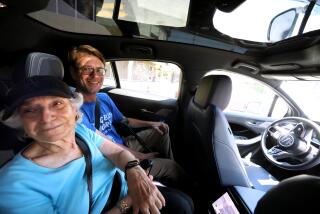Column: It’s time cellphone signal jammers were installed in people’s steering wheels
- Share via
A couple of years ago, a Florida man was fined $48,000 by the Federal Communications Commission for employing an illegal signal jammer during his commutes to prevent nearby drivers from using their cellphones.
I can relate. I bet you can too.
It’s illegal to have a cellphone in your hand while behind the wheel in California and at least a dozen other states. But that doesn’t stop people from doing it.
Not a day goes by without encountering thoughtless, self-entitled fools endangering themselves and those around them by talking or texting while on the road.
That’s why I’m calling on the auto industry to install signal-jamming technology in steering wheels so drivers (but not passengers) are unable to give in to the temptation of playing with their gadgets while piloting 3,000 pounds of steel at speeds topping 60 miles an hour.
Admittedly, the matter is complicated.
“If it’s an option for parents to get their kids off on the right footing and develop safe driving habits, that could be a real safety benefit,” said Rosemary Shahan, president of Consumers for Auto Reliability and Safety, a Sacramento-based advocacy group.
“But if it’s envisioned as a way to modify the behavior of all drivers, it seems unlikely that those who are the worst offenders in terms of using their phones would be inclined to purchase that option,” she told me.
And if such technology was mandatory, Shahan observed, “what about being able to reach 911 in an emergency where it’s not safe to pull off the road, or to use a phone to navigate or get directions?”
These are big questions. But we’re facing a big problem.
The National Highway Traffic Safety Administration says 37,133 people died last year in motor vehicle crashes, and more than 3,000 of those deaths involved distracted drivers. Thousands more people are injured annually by drivers who take their eyes off the road.
I reached out to the Alliance of Automobile Manufacturers, an industry group, to get a sense of where carmakers stand. Bryan Goodman, a spokesman for the organization, said automakers take the matter seriously.
“We can all agree that hands on the wheel and eyes on the road continue to be critical to safe driving,” he said, adding that cellphones “were never designed to be used while driving.”
But there’s only so much the industry can do, Goodman insisted. He emailed me a link to an FCC page addressing the issue.
It says that “federal law prohibits the operation, marketing or sale of any type of jamming equipment, including devices that interfere with cellular and Personal Communication Services (PCS), police radar, Global Positioning Systems (GPS) and wireless networking services (Wi-Fi).”
The FCC states in no uncertain terms that “these devices pose serious risks to critical public safety communications, and can prevent you and others from making 911 and other emergency calls. Jammers can also interfere with law enforcement communications.”
“Jamming devices create serious safety risks,” P. Michele Ellison, chief of the agency’s Enforcement Bureau, says in a statement on the web page. “In the coming weeks and months, we’ll be intensifying our efforts through partnerships with law enforcement agencies to crack down on those who continue to violate the law.”
There it is.
The FCC, however, is wrong.
The agency is living in a world where low-power signal jammers might have a range of about 30 feet, while more advanced gear could block all transmissions within the size of a football field. These obviously raise public-safety questions.
But what if small-scale jamming technology could be installed in a steering wheel with a range of just inches — not enough to affect surrounding vehicles, or even other occupants of the car, but sufficient to keep drivers from being stupid?
What if that technology could be flexible enough to not interfere with medical devices such as pacemakers or insulin pumps? Or with streaming-music services?
What if, most importantly, it didn’t mess with law enforcement or emergency calls?
“It could be done,” said Todd Humphreys, an associate professor of engineering at the University of Texas at Austin. “Properly calibrated, the jamming would be enough to overpower the driver’s phone near the steering wheel but not quite enough to overpower passengers’ phones.”
He said the jammer could use algorithms to adjust its output relative to changes in cell signal strength as a vehicle moves, so the jamming field remained consistent.
However, there’s always the human factor.
Humphreys noted, correctly, that some knuckle-dragging drivers (my words, not his) would be tempted to skirt the jamming field by holding their phone at arm’s length or leaning way back in their seat.
“This might lead to a situation that’s even more dangerous than the one we’re trying to prevent,” he said.
T. Charles Clancy, executive director of the Hume Center for National Security and Technology at Virginia Tech, had the same thought.
“If you’re texting and driving now, you’ll use whatever wingspan you have to get around the jamming technology,” he said.
The trick, said A. Lee Swindlehurst, a professor of electrical engineering and computer science at UC Irvine, is “to find a sweet spot where only the driver’s device is jammed,” regardless of where he or she holds their phone.
This is technically feasible, he said, “but it would be a challenging design.”
Maybe we don’t want to go the jamming route. Maybe instead we equip all cellphones so that if their sensors and cameras detect motion, or if they see that the user is rapidly raising and lowering their eyes while driving, they don’t permit texting.
Marwan Krunz, a professor of electrical and computer engineering at the University of Arizona, said it also may be feasible to develop jamming technology that blocks incoming signals but doesn’t prevent outbound calls, which would address the issue of emergency situations.
The point is that there are potential solutions out there, as long as federal authorities are open to change.
No one at the FCC responded to my repeated requests for comment.
That Florida guy who was hit with the $48,000 fine apparently had been jamming people’s cellphones on the freeway for a couple of years. He was charged with “use of an illegal device” and was told to knock it off.
Points for chutzpah, though.
More people are killed every year by distracted driving than were killed in the Sept. 11 terrorist attacks. That should make it obvious we’ve got a major public-safety threat on our hands.
Doing nothing shouldn’t be an option.
David Lazarus’ column runs Tuesdays and Fridays. He also can be seen daily on KTLA-TV Channel 5 and followed on Twitter @Davidlaz. Send your tips or feedback to [email protected].







